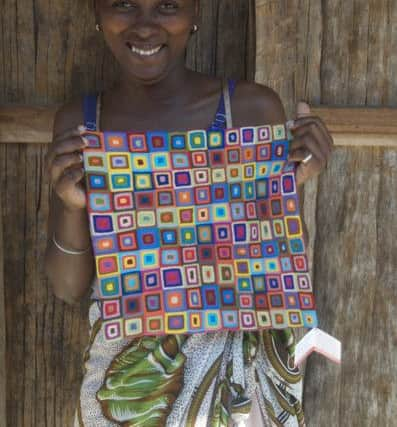Sarah sews to seeds of change


When Sarah Brown, an artist and University lecturer, visited Madagascar looking for inspiration for her art she had no idea it would change her life forever.
A successful embroidery artist, creating installation artwork for galleries based on sewing techniques, Sarah also lectured at Leeds College of Art.
Advertisement
Hide AdAdvertisement
Hide AdIn the summer of 2011, during her summer holiday, she signed up to visit Madagascar for a few weeks, with a charity called Azafady, as a way to see some wildlife she hoped would inspire her art for the coming year.


But whilst the wildlife she saw was amazing it was the people in Madagascar that really inspired her. She was deeply struck by the contrast between the young women she was teaching in Leeds, aspiring students with ambition, creativity and passion, and the girls in the village she was staying in, Sainte Luce, who had no options other than marriage and motherhood, many being illiterate and all having endured real hardship in their lives due to extreme poverty.
But these hardships hadn’t killed the women’s creativity and Sarah was amazed by how people improvised to fix things and solve problems and the amount of visual culture there was in the hair plaiting, basket weaving and roof thatching she saw.
It struck Sarah that, with just a little direction, some of the women’s creativity could be put to great use. Most of the youngsters in the village were dressed in rags, having to pull their trousers up to keep them from falling down, and just a few people skilled with a needle and thread could make an easy, but impactful difference for these children. But Sarah saw beyond just keeping trousers up and recognised there was potential for a project that used people’s creative skills to bring an income stream in to the village and help women lift themselves out of the poverty trap they had fallen into.
Advertisement
Hide AdAdvertisement
Hide AdSo Sarah held a meeting with the Chief of the village about whether a textile and embroidery project would be useful to the village and talked to some of the female elders about what they would want from a venture of this kind.


The community were incredibly enthusiastic about the concept and fully supported the idea, but needed someone to head it up – Sarah dutifully put herself forward, not fully appreciating the impact it would have on her life.
Sarah wanted to work with Azafady on the project and needed their help to get it off the ground – the charity having a large base of knowledge and trust built through years working with the community in Sainte Luce and the wider area. So when she returned to the UK, in time for the start of the University term, she spent her spare time with Azafady to develop the project into a viable one year pilot, writing a proposal and securing funding.
After 10 months it was all arranged, she worked two months’ notice on her job and then packed up her life and took it to Sainte Luce.
Advertisement
Hide AdAdvertisement
Hide AdSarah gave up a comfortable life in Leeds and swapped her flat and studio space for a wooden house with no electricity or running water. Her lecturing and art work was replaced by teaching Madagascan women sewing skills to produce beautiful works of embroidery for sale. The women quickly picked up the skills required and it wasn’t long before they were producing incredible bags, belts, bracelets and cushion covers. These were hugely popular with the foreign volunteers and ‘off the beaten track’ tourists who came to the village and a steady income stream slowly started to dribble in. Seeing there was room for sales further afield Sarah set up a website for the project and the items began selling on the internet.
It was certainly a baptism of fire for Sarah when she first arrived in Sainte Luce to live full time, but she quickly learnt to love her new life and the satisfaction she gets from seeing the women of the village growing in confidence and how the income stream has begun to change their lives.
“When I arrived I had this grand plan for the project, but I had no idea whether it was actually going to work, whether we would be able to make good products, or whether anyone would want to buy them. That was very daunting, I didn’t know what barriers we were going to face. Whilst teaching was something that I had a lot of experience of, living in the village was a steep learning curve,” says Sarah.
“The women were astounded that I couldn’t carry a bucket of water on my head, weave a mat, or winnow rice, skills they learnt as children. The whole community supported me to learn these basics and still people constantly teach me better ways to do things. So there is a lot of positivity but there are also real lows, when the village is going through particularly difficult times, like when there are a lot of deaths or when the weather is bad and the fishermen can’t go to sea so the whole village is hungry. The change I have seen in my students is extraordinary. Not just in terms of financial benefit, but their attitudes too.
Advertisement
Hide AdAdvertisement
Hide Ad“If I ever question the value of what we are doing, the journey that every single one of these women has been on reminds me that all the hard work is worth it.” Sarah is now determined to stay until the project is fully sustainable and the women can generate income indefinitely without her support. So far she has been in the village for two and a half years and will be involved for at least another two as she continues to train the women to sell their wares.
www.stitchsainteluce.